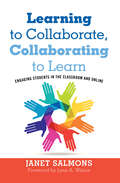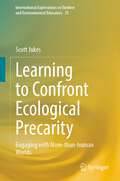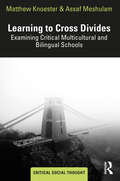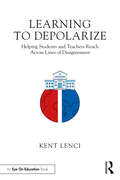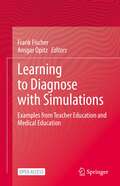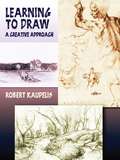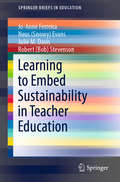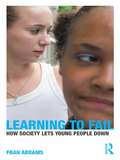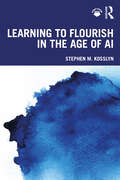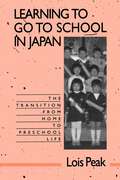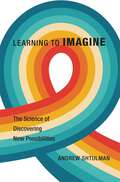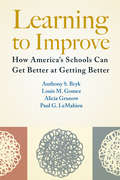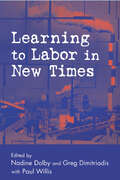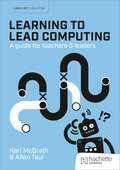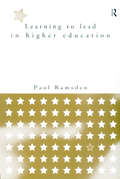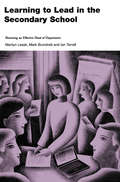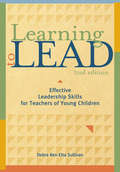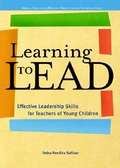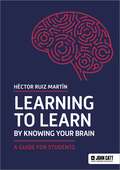- Table View
- List View
Learning to Change Lives
by A. Ka TsangThe Strategies and Skills Learning and Development (SSLD) system is an action-oriented model for enabling clients in social work, health, mental health, and human services settings to address their needs and life goals. In Learning to Change Lives, author A. Ka Tat Tsang introduces SSLD's powerful framework and practice, which has been developed based on three decades of experience in psychotherapy, counselling, education, training, consultation, and community service.Learning to Change Lives provides detailed, step-by-step guidelines for SSLD intervention - starting with engagement with the client, assessment, translating problems into intervention plans, systematic learning and development of appropriate strategies and skills. Key practice procedures are described clearly and illustrated by case examples, specific instructions, and sample worksheets. Aimed at clinical practitioners, mental health professionals, social workers, and other human service professionals, this book can be used as a manual by practitioners and as a textbook for courses and training programs.
Learning to Collaborate, Collaborating to Learn: Engaging Students in the Classroom and Online
by Janet SalmonsStudents who know how to collaborate successfully in the classroom will be better prepared for professional success in a world where we are expected to work well with others. Students learn collaboratively, and acquire the skills needed to organize and complete collaborative work, when they participate in thoughtfully-designed learning activities.Learning to Collaborate, Collaborating to Learn uses the author’s Taxonomy of Online Collaboration to illustrate levels of progressively more complex and integrated collaborative activities.- Part I introduces the Taxonomy of Online Collaboration and offers theoretical and research foundations.- Part II focuses on ways to use Taxonomy of Online Collaboration, including, clarifying roles and developing trust, communicating effectively, organizing project tasks and systems.- Part III offers ways to design collaborative learning activities, assignments or projects, and ways to fairly assess participants’ performance.Learning to Collaborate, Collaborating to Learn is a professional guide intended for faculty, curriculum planners, or instructional designers who want to design, teach, facilitate, and assess collaborative learning. The book covers the use of information and communication technology tools by collaborative partners who may or may not be co-located. As such, the book will be appropriate for all-online, blended learning, or conventional classrooms that infuse technology with “flipped” instructional techniques.
Learning to Confront Ecological Precarity: Engaging with More-than-human Worlds (International Explorations in Outdoor and Environmental Education #13)
by Scott JukesThis volume presents innovative approaches for confronting environmental issues and socio-ecological inequality within Outdoor Environmental Education (OEE). Through experimentation with alternative pedagogical possibilities, it explores what OEE can do in response to ecological precarity. Drawing upon posthumanist theory, it focuses on the enactment of more-than-human pedagogies that foster affirmative environmental relationships while challenging problematic cultural perspectives. The 12 chapters explore various topics, including place-responsive pedagogies, environmental stories, new materialist theoretical insights and waste education practices, engaging with complex environmental issues such as species extinction and climate change in the context of OEE. This book provides practical examples and conceptual creativity to extend contemporary theoretical currents. It offers innovative pedagogical strategies and methodological insights for OEE. Researchers, students, and practitioners of OEE interested in applying posthumanist ideas to their work will find this volume most interesting.
Learning to Cross Divides: Examining Critical Multicultural and Bilingual Schools (Critical Social Thought)
by Matthew Knoester Assaf MeshulamThis volume demonstrates how multilingual schooling can enhance democracy through a connection with the policies and practices of critical education. With its in-depth analysis of real schools that focus on the dual emphases of multiculturalism and integration, this book offers a comparative look at educational and political controversies over race, citizenship, and societal power relations. The authors describe the ambitious goals and critical multicultural and bilingual education strategies used at these schools, and, in doing so, they highlight how the challenges involved relate to larger theoretical issues that are inherent to a critically multicultural and bilingual education. This book examines what a truly critical multicultural and bilingual education means and what it requires of those who are intimately connected with these processes. As such, it will be important reading for those studying, teaching, or researching in Sociology of Education, Multicultural Education, Multilingual and Bilingual Education, Educational Policy, and Critical Education Studies.
Learning to Cross Divides: Examining Critical Multicultural and Bilingual Schools (Critical Social Thought)
by Matthew Knoester Assaf MeshulamThis volume demonstrates how multilingual schooling can enhance democracy through a connection with the policies and practices of critical education.With its in-depth analysis of real schools that focus on the dual emphases of multiculturalism and integration, this book offers a comparative look at educational and political controversies over race, citizenship, and societal power relations. The authors describe the ambitious goals and critical multicultural and bilingual education strategies used at these schools, and, in doing so, they highlight how the challenges involved relate to larger theoretical issues that are inherent to a critically multicultural and bilingual education.This book examines what a truly critical multicultural and bilingual education means and what it requires of those who are intimately connected with these processes. As such, it will be important reading for those studying, teaching, or researching in Sociology of Education, Multicultural Education, Multilingual and Bilingual Education, Educational Policy, and Critical Education Studies.
Learning to Depolarize: Helping Students and Teachers Reach Across Lines of Disagreement
by Kent LenciHow can schools shoulder some responsibility for depolarizing our fractured American society? In this provocative new book, Kent Lenci describes how educators can tackle the challenge of preparing students to communicate and collaborate across lines of deep disagreement—to face the political and ideological "other"—despite the conventional wisdom that schools should be apolitical. Topics covered include the causes and consequences of political polarization in our society, why schools must address the challenge head-on, bridge-building in the classroom, media literacy and social emotional learning as tools for depolarization, and partnering with parents across the divide. Each chapter offers current research as well as practical strategies and classroom anecdotes. Appropriate for teachers of all grade levels and subject areas, the book will help you reconsider your classroom and school’s role in forging a more depolarized future.
Learning to Diagnose with Simulations: Examples from Teacher Education and Medical Education
by Frank Fischer Ansgar OpitzThis open access book presents 8 novel approaches to measure and improve diagnostic competences with simulation. The book compares the effects of interventions on these diagnostic competences in both teacher and medical education. It includes analyses showing that important aspects of diagnostic competences and effects of instructional interventions aiming to facilitate them are comparable for teachers and doctors. Through closely analyzing projects from medical education, mathematics education, biology education, and psychology, the reader is presented with multiple options for interventions that may be used in each of the subject areas and the improvements in diagnostic skills that could be expected from each simulation. The book concludes with an outline of promising future research on the use of simulations to facilitate professional competences in higher education in general, and for the advancement of diagnostic competencies in particular.This is an open access book.
Learning to Draw: A Creative Approach (Dover Art Instruction)
by Robert KaupelisTeachers, students, and amateur artists will all benefit from the advice of this esteemed educator and fine artist whose book, as described by a colleague, is "a cause célèbre for art education, not only because it meets the urgent professional need, but also because it combines artistic, aesthetic, and instructional considerations in a way which is significantly different from any other text."Encouraging teachers and students to use his suggestions in ways they feel most appropriate, the author (an expert guide and teacher) offers sound advice on methods and techniques for artists at all levels. Using the lessons and methods he employed over the years as an instructor, Kaupelis focuses on solving the problems common to many illustrators, among them successfully developing perspective, contour and modeled drawing, and drawing from memory and projected images. A splendid blend of instruction, analysis, and insights, this volume--one of the most widely read art instruction texts--deserves a place on the shelves of instructors and serious students of art.
Learning to Embed Sustainability in Teacher Education (SpringerBriefs in Education)
by Julie M. Davis Jo-Anne Ferreira Neus (Snowy) Evans Robert (Bob) StevensonThis book offers an accessible guide to understanding the importance of a systems approach to embedding sustainability into teacher education practice, providing a practical resource for teacher education academics and others with an interest in organisational change. It draws principally on the findings of a 12-year research project in Australia, working directly with academics and their teacher education institutions to ensure that sustainability and education for sustainability are embedded in teacher education courses. Illustrating the need for change in teacher education in the context of education for sustainability, the book discusses the theory underpinning and practical application of a system-based change model. It also offers examples of how the model has been used in practice and shows education academics how to implement change within their own organizations and use the ideas and tools presented to advance sustainability in their discipline areas.
Learning to Fail: How Society Lets Young People Down
by Fran AbramsDuring a decade of relative prosperity from the mid-1990s onward, governments across the developed world failed to crack one major issue – youth unemployment. Even when economic growth was strong, one young person in 10 in the United Kingdom was neither working nor learning. As the boom ended, the number of young people dropping out after leaving school – already acknowledged to be too high - began to rise at an alarming rate. As governments face up to the prospect of a new generation on the dole, this book examines the root causes of the problem. By holding a light to the lives and attitudes of eight young people, their families, their teachers and their potential employers, this book will challenge much of what has been said about educational success and failure in the past 20 years. For two decades, policy makers largely assumed schools were the key to ensuring young people got the best possible start in life. Yet for many children the path to failure began well before their first day at school. Through the stories of these young people, this book reveals how marginalised young people are let down on every step of their journey. Growing up in areas where aspiration has died or barely ever existed, with parents who struggle to guide them on life in the 21st century, they are let down by schools where teachers underestimate them, by colleges and careers advisers who mislead them and by an employment market which has forgotten how to care or to nurture. Learning to Fail goes behind the headlines about anti-social behaviour, drugs and teenage pregnancy to paint a picture of real lives and how they are affected by outside forces. It gives a voice to ordinary parents and youngsters so they can speak for themselves about what Britain needs to do to turn its teenage failures into a success story.
Learning to Flourish in the Age of AI
by Stephen M. KosslynThis timely book affirms that humans can flourish in the Age of AI by relying on their distinctive strengths, and explores the skills and knowledge that are required to interact effectively, efficiently, and responsibly with AIs, both today and in the future.In Part I, this book develops the "Cognitive Amplifier Loop," which allows humans to use AI to build on their cognitive and emotional strengths and manage their limitations. Kosslyn discusses ways to employ this loop to offload tasks to AI and to utilize it to train us effectively and efficiently, as well as how to use it to both learn and engage in critical thinking, creative problem solving, and manage cognitive and emotional constraints. Part II establishes how to draw on the Cognitive Amplifier Loop to help us improve our human relationships, addressing emotional intelligence, effective communication, leadership, followership, and collaboration skills. Finally, Part III builds on previous chapters to consider how to interact with AIs to help each of us learn and grow. Throughout the book, Kosslyn provides practical strategies and AI-assisted exercises to help readers develop these essential skills and knowledge. Kosslyn argues that by cultivating distinctively human capabilities, we can not only coexist with AI but flourish in an AI-infused world.This book is a must-read for anyone involved with AI, education, or Learning and Development in industry. It will also appeal to anyone studying thinking and decision making, AI and psychology, and the use of technology in the classroom.
Learning to Go to School in Japan: The Transition from Home to Preschool Life
by Lois PeakJapanese two-year-olds are indulged, dependent, and undisciplined toddlers, but by the age of six they have become obedient, self-reliant, and cooperative students. When Lois Peak traveled to Japan in search of the "magical childrearing technique" behind this transformation, she discovered that the answer lies not in the family but in the preschool, where teachers gently train their pupils in proper group behavior. Using case studies drawn from two contrasting schools, Peak documents the important early stages of socialization in Japanese culture.Contrary to popular perceptions, Japanese preschools are play-centered environments that pay little attention to academic preparation. It is here that Japanese children learn their first lessons in group life. The primary goal of these cheerful--even boisterous--settings is not to teach academic facts of learning-readiness skills but to inculcate behavior and attitudes appropriate to life in public social situations.Peak compares the behavior considered permissible at home with that required of children at preschool, and argues that the teacher is expected to be the primary agent in the child's transition. Step by step, she brings the socialization process to life, through a skillful combination of classroom observations, interviews with mothers and teachers, transcripts of classroom events, and quotations from Japanese professional literature.
Learning to Imagine: The Science Of Discovering New Possibilities
by Andrew ShtulmanAn award-winning cognitive scientist offers a counterintuitive guide to cultivating imagination.Imagination is commonly thought to be the special province of youth—the natural companion of free play and the unrestrained vistas of childhood. Then come the deadening routines and stifling regimentation of the adult world, dulling our imaginative powers. In fact, Andrew Shtulman argues, the opposite is true. Imagination is not something we inherit at birth, nor does it diminish with age. Instead, imagination grows as we do, through education and reflection.The science of cognitive development shows that young children are wired to be imitators. When confronted with novel challenges, they struggle to think outside the box, and their creativity is rigidly constrained by what they deem probable, typical, or normal. Of course, children love to “play pretend,” but they are far more likely to simulate real life than to invent fantasy worlds of their own. And they generally prefer the mundane and the tried-and-true to the fanciful or the whimsical.Children’s imaginations are not yet fully formed because they necessarily lack knowledge, and it is precisely knowledge of what is real that provides a foundation for contemplating what might be possible. The more we know, the farther our imaginations can roam. As Learning to Imagine demonstrates, the key to expanding the imagination is not forgetting what you know but learning something new. By building upon the examples of creative minds across diverse fields, from mathematics to religion, we can consciously develop our capacities for innovation and imagination at any age.
Learning to Improve: How America's Schools Can Get Better at Getting Better
by Anthony S. Bryk Alicia Grunow Paul G. Lemahieu Louis M. GomezAs a field, education has largely failed to learn from experience. Time after time, promising education reforms fall short of their goals and are abandoned as other promising ideas take their place. In Learning to Improve, the authors argue for a new approach. Rather than "implementing fast and learning slow," they believe educators should adopt a more rigorous approach to improvement that allows the field to "learn fast to implement well." Using ideas borrowed from improvement science, the authors show how a process of disciplined inquiry can be combined with the use of networks to identify, adapt, and successfully scale up promising interventions in education. Organized around six core principles, the book shows how "networked improvement communities" can bring together researchers and practitioners to accelerate learning in key areas of education. Examples include efforts to address the high rates of failure among students in community college remedial math courses and strategies for improving feedback to novice teachers. Learning to Improve offers a new paradigm for research and development in education that promises to be a powerful driver of improvement for the nation's schools and colleges. "In this hopeful and accessible volume, Bryk and his colleagues describe six tenets for addressing vexing problems of educational practice. Yes, systematic actions guided by serious scientific inquiry can lead to improvements in a vast array of contexts, topics, and settings. Drawing on numerous real life examples and illustrations, the authors demonstrate how to develop and then critically execute good ideas to produce reliably positive outcomes." --John Q. Easton, distinguished senior fellow, Spencer Foundation
Learning to Improve: How America’s Schools Can Get Better at Getting Better
by Anthony S. Bryk Alicia Grunow Louis M. Gomez Paul G. LeMahieuAs a field, education has largely failed to learn from experience. Time after time, promising education reforms fall short of their goals and are abandoned as other promising ideas take their place. In Learning to Improve, the authors argue for a new approach. Rather than &“implementing fast and learning slow,&” they believe educators should adopt a more rigorous approach to improvement that allows the field to &“learn fast to implement well.&” Using ideas borrowed from improvement science, the authors show how a process of disciplined inquiry can be combined with the use of networks to identify, adapt, and successfully scale up promising interventions in education. Organized around six core principles, the book shows how &“networked improvement communities&” can bring together researchers and practitioners to accelerate learning in key areas of education. Examples include efforts to address the high rates of failure among students in community college remedial math courses and strategies for improving feedback to novice teachers. Learning to Improve offers a new paradigm for research and development in education that promises to be a powerful driver of improvement for the nation&’s schools and colleges.
Learning to Kneel: Noh, Modernism, and Journeys in Teaching (Modernist Latitudes)
by Carrie J. PrestonIn this inventive mix of criticism, scholarship, and personal reflection, Carrie J. Preston explores the nature of cross-cultural teaching, learning, and performance. Throughout the twentieth century, Japanese noh was a major creative catalyst for American and European writers, dancers, and composers. The noh theater’s stylized choreography, poetic chant, spectacular costumes and masks, and engagement with history inspired Western artists as they reimagined new approaches to tradition and form. In Learning to Kneel, Preston locates noh’s important influence on such canonical figures as Pound, Yeats, Brecht, Britten, and Beckett. These writers learned about noh from an international cast of collaborators, and Preston traces the ways in which Japanese and Western artists influenced one another.Preston’s critical work was profoundly shaped by her own training in noh performance technique under a professional actor in Tokyo, who taught her to kneel, bow, chant, and submit to the teachings of a conservative tradition. This encounter challenged Preston’s assumptions about effective teaching, particularly her inclinations to emphasize Western ideas of innovation and subversion and to overlook the complex ranges of agency experienced by teachers and students. It also inspired new perspectives regarding the generative relationship between Western writers and Japanese performers. Pound, Yeats, Brecht, and others are often criticized for their orientalist tendencies and misappropriation of noh, but Preston’s analysis and her journey reflect a more nuanced understanding of cultural exchange.
Learning to Kneel: Noh, Modernism, and Journeys in Teaching (Modernist Latitudes)
by Carrie J. PrestonIn this inventive mix of criticism, scholarship, and personal reflection, Carrie J. Preston explores the nature of cross-cultural teaching, learning, and performance. Throughout the twentieth century, Japanese noh was a major creative catalyst for American and European writers, dancers, and composers. The noh theater's stylized choreography, poetic chant, spectacular costumes and masks, and engagement with history inspired Western artists as they reimagined new approaches to tradition and form. In Learning to Kneel, Preston locates noh's important influence on such canonical figures as Pound, Yeats, Brecht, Britten, and Beckett. These writers learned about noh from an international cast of collaborators, and Preston traces the ways in which Japanese and Western artists influenced one another. Preston's critical work was profoundly shaped by her own training in noh performance technique under a professional actor in Tokyo, who taught her to kneel, bow, chant, and submit to the teachings of a conservative tradition. This encounter challenged Preston's assumptions about effective teaching, particularly her inclinations to emphasize Western ideas of innovation and subversion and to overlook the complex ranges of agency experienced by teachers and students. It also inspired new perspectives regarding the generative relationship between Western writers and Japanese performers. Pound, Yeats, Brecht, and others are often criticized for their orientalist tendencies and misappropriation of noh, but Preston's analysis and her journey reflect a more nuanced understanding of cultural exchange.
Learning to Labor in New Times (Critical Social Thought)
by Paul Willis Nadine Dolby Greg DimitriadisLearning to Labor in New Times foregrounds nine essays which re-examine the work of noted sociologist Paul Willis, 25 years after the publication of his seminal Learning to Labor, one of the most frequently cited and assigned texts in the cultural studies and social foundations of education.
Learning to Lead Computing: A guide for teachers and leaders
by Karl McGrath Allen TsuiIn Learning To Lead Computing, Karl McGrath and Allen Tsui provide an essential, jargon-free guide for educators tasked with leading computing at their school. Drawing from over a decade of experience in education, the authors deliver practical advice and strategies to engage and inspire both colleagues and empower them as leaders. This comprehensive handbook offers step-by-step instructions on everything from curriculum sequence to staff motivation, sharing research-backed approaches such as PRIMM and Parsons problems to encourage deeper thinking about computing in the classroom. Karl McGrath and Allen Tsui's approachable style, ensures that even non-specialists can confidently lead computing education. Ideal for ECTs, computing subject leads and senior leaders, this book transforms complex subjects into engaging and manageable content, empowering educators to foster a generation of tech-savvy digital citizens.
Learning to Lead Computing: A guide for teachers and leaders
by Karl McGrath Allen TsuiIn Learning To Lead Computing, Karl McGrath and Allen Tsui provide an essential, jargon-free guide for educators tasked with leading computing at their school. Drawing from over a decade of experience in education, the authors deliver practical advice and strategies to engage and inspire both colleagues and empower them as leaders. This comprehensive handbook offers step-by-step instructions on everything from curriculum sequence to staff motivation, sharing research-backed approaches such as PRIMM and Parsons problems to encourage deeper thinking about computing in the classroom. Karl McGrath and Allen Tsui's approachable style, ensures that even non-specialists can confidently lead computing education. Ideal for ECTs, computing subject leads and senior leaders, this book transforms complex subjects into engaging and manageable content, empowering educators to foster a generation of tech-savvy digital citizens.
Learning to Lead in Higher Education
by Paul RamsdenThe future success of our universities depends on academics' capacity to respond energetically to change. To help academics face new and uncertain demands, we need an entirely different approach to their management and leadership. This book shows academic leaders how to increase resource productivity and enhance teaching quality. It also demonstrates how leaders can help their staff through momentous change without compromising professional standards.Drawing on ideas from the world of business leadership as well as research into what makes academics committed and productive, Learning to Lead in Higher Education provides heads of departments and course leaders with practical tools they can use to improve their management and leadership skills. It shows academic and university leaders at all levels how they can turn adversity into prosperity.
Learning to Lead in the Secondary School: Becoming an Effective Head of Department
by Mark Brundrett Ian TerrellLearning to Lead in the Secondary School is designed to meet the needs of subject leaders and heads of department in secondary schools, offering practical advice and guidance to teachers taking on these demanding roles. This highly informative book is structured around six sections that address all of the key areas in leading a department including: * becoming a subject leader* managing effective teaching and learning* leading and managing people* the strategic direction and development of a department* the deployment of staff and resources* managing personal performance and development. This guide will be invaluable to middle managers in schools, subject leaders and heads of departments. It will be of interest to teachers and managers at all levels and will also be useful to those undertaking research or further qualifications in educational leadership and management.
Learning to Lead, Second Edition
by Debra Ren-Etta SullivanLearning to Lead combines theory and practice with important topics such as human development, diversity, anti-bias, and social change. New to this edition is information on leadership connections in school-age care and nurturing leadership in children. Each chapter is designed to prompt self-evaluation and personal leadership development.
Learning to Lead: Effective Leadership Skills for Teachers of Young Children
by Debra Ren-Etta SullivanDiscover the natural leader inside of you! Everyone who works with children is a teacher and a leader. An in-depth look at how leadership skills impact all areas of early childhood care and education, Learning to Lead combines accessible leadership theory and practice with important topics and issues such as human development, diversity, anti-bias, work with families, and social change. Each chapter is built around a combination of theories, examples, and reflection questions - all designed to prompt self-evaluation and personal leadership development. Learning to Lead is a must-have resource for early childhood teachers at all levels.
Learning to Learn by Knowing Your Brain: A Guide for Students
by Héctor Ruiz MartínDid you know that science has revealed what actions and circumstances make your brain learn more effectively?In this book, a scientist explains in a simple and very entertaining way how your brain learns and what you can do to take advantage of its full potential.Among other things, you will find out that:- Both people who are good at learning and those who are not can improve their performance if they use the right learning strategies: those that align with the way the brain learns best!- Most students do not know these strategies and those who spontaneously develop them gain a huge advantage without even realizing it.- Your brain is much more powerful than you realize in terms of its ability to learn. Every time you learn something, your brain changes its structure!When you learn about how the brain learns, you learn to learn!

